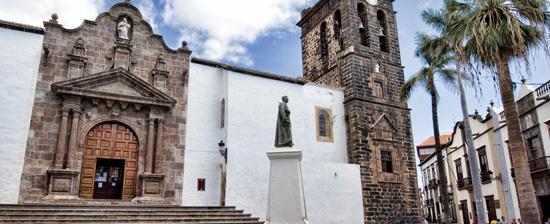Santa Cruz de la Palma is probably one of the most beautiful Canarian capitals. Idyllic city, where he lives 20 thousand. people, lives at a completely different pace than the rest of the world. Time in Santa Cruz doesn't matter that much, that you can see Christmas decorations on the main street even in the middle of summer.
Neighborhood Calle O’Daly
You can start your tour by walking along the main shopping street, calle O’Daly (the name comes from an Irish banana trader, who lives on the island permanently), starting at Plaza de la Constitución. Along the street there are traditional colonial tenement houses and attractive merchant houses – is a memento of the city's greatness. About the middle of calle O'Daly there is a small square, España Beach, considered the most important example of Renaissance architecture in the archipelago. To the west, a palm-lined square closes the Ayuntamiento building (town hall) from 1569 r. (during office hours you can look inside), and to the north Iglesia del Salvador. Resembling a fortress, the church has a beautiful wooden ceiling and an unusual sacristy with Gothic arches. In addition, there is a small fountain with drinking water in the square, built on the site of the town hall destroyed by pirates, and the beautiful building of the Open University.
A small set of steps leads from Plaza España to Calle San Sebastian, next to which there is a pretty chapel of the same name. A few steps further south you can see a nice square and the Santo Domingo Church. Hundred meters south of Santo Domingo beach, next to the Virgen de la Luz it is worth seeing the Ermita de Nuestra Seńora de la Luz chapel and entering the viewpoint.
Towards the Plaza de la Alameda
Tuż za Avenida El Puente 0’Daley street zamienia się w Anselmo Perez de Brito street. Turning into the first narrow street on the left, you come to the back of the nice town market – Municipal market – and the historic Teatro Chico. When, after a few hundred meters, the calle Anselmo Perez de Brito turns from a pleasant promenade into a street filled with cars, it is worth turning into calle Baltasar Martin, where you can see traditional houses showing Andalusian influences, and then all over San Francisco, which leads to the square of the same name. A pretty Renaissance Iglesia de San Francisco stands by the square, and in the adjacent building of the former Franciscan monastery, the Museo Insular was created, where you can see painting exhibitions, ethnographic and archaeological. The Beach de la Alameda, planted with thick Indian laurels, is just a few steps away. There is a monument in the southern part of the square, created for the occasion 400. anniversary of the city foundation – It is said that this is where Alonso de Lugo stuck the famous wooden cross into the ground. Attention is drawn to a large galleon in the northern part of the square – as if taken out of a sea story, the tall ship is a brick replica of Christopher Columbus "Santa Maria". Inside, at least theoretically, it houses the Museo Naval, however, it is difficult to say anything about it, because the museum has been closed and renovated for a long time.
On the other side of the Barranco de las Nieves
It's hard to know, but in the northern part the city is not crossed by the riverbed, and starting in the Barranco de las Nieves mountains. It used to be used as a parking lot - the idea was abandoned, when, after intense rainfall, the water flowing from the mountains flooded the vehicles standing in the ravine. You can cross a small bridge to the other side, to następnie wspinając się Carretera de las Nieves and Cuesta de la Encarnación, you reach the world forgotten Beach de la Encarnación, from where there is a beautiful panorama of Santa Cruz.
Along the coast
Avenida Marftima is also worth a walk, with charming colorful houses with traditional Canarian wooden balconies and the 17th-century Castillo de Santa Catalina.
Descent of the Virgen de las Nieves
From 1680 r. every five years Santa Cruz de la Palma celebrates the patron saint of the island, Virgin of the Snows – it is by far the most important and biggest fiesta on the island. In the last week of June, the statue of the Virgen de las Nieves is carried to Santa Cruz de la Palma in a solemn procession. On the night before the arrival of the Virgin Mary, there are dances and performances in the streets of the city, including the most important of them – Dance of the Dwarves (Card Dance).
